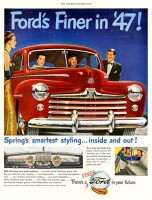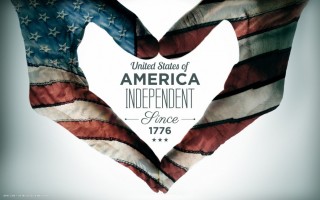Finding Life Itself
The views expressed are those of the author and do not necessarily reflect the views of ASPA as an organization.
By Jason Bowns
July 7, 2017
In the immediate aftermath of World War II, American soldiers were returning home. General MacArthur remained in Japan to oversee its reconstruction. U.S. Supreme Court Justice Robert Jackson was one of four chief prosecutors arguing cases at the Nuremberg trials in Germany. Against this backdrop, Congress enacted the Lanham Act which went into effect on July 5, 1947.
The son of a Texas governor, U.S. Representative Fritz Garland Lanham championed the bill reforming trademark law and making a legal cause of action for infringement. Still in its infancy, television broadcasting also began that same year, opening a whole new arena for trademarking far beyond radio programs, billboards and movie theaters.

Today, the Lanham Act functions as a primary authority not only for the commercial images and advertising we see on television. In the beginning, even YouTube was ad-free, but now we’re bombarded with logos and slogans all over the internet with an ever-increasing frequency. Many of those are trademarked, too. Even the YouTube logo itself was registered as early as 2008.
Companies may still use an unregistered logo, but trademarks already registered with the United States Patent and Trademark Office (U.S. PTO) offer a stronger defense against infringement.
Section 2a of the Lanham Act contains the “disparagement clause.” That prevents the U.S. PTO from approving any mark which “consists of…matter which may disparage or falsely suggest a connection with persons, living or dead, institutions, beliefs, or national symbols, or bring them into contempt or disrepute.”
On that basis, litigants successfully won cancellation of the Washington Redskins’ trademarked symbols after finding that the team name disparaged Native Americans.

In June 2014, the U.S. PTO Board concluded, “The recognition that this racial designation based on skin color is disparaging to Native Americans is also demonstrated by the near complete drop-off in usage of ‘redskins’ as a reference to Native Americans beginning in the 1960s.”
The Board pointed out while many may not find the term to be disparaging now, the word was disparaging when those trademarks were issued. This rationale led to their cancellation.
Then along came The Slants, a punk rock band aiming to redefine a term used to disparage Asians. The U.S. PTO denied their trademark registration application under the Lanham Act. Eventually, Simon Tam presented his legal claim in Washington, DC. That’s when his attorney argued the case to trademark that band’s name before the United States Supreme Court.
Remember the Lanham Act’s Section 2a disparagement clause endured wholly unabridged for 70 years; guidance for denying trademark applications on that basis comprises a key part of the Trademark Examining Manual. Language there speculates the original legislative purpose was to protect individual privacy and identity from commercial exploitation.
Associate Justice Samuel Alito penned the majority opinion decided on June 19, 2017. The Court considered whether Section 2a had some larger First Amendment implications. Specifically, are trademarks a form of protected speech?
Because the Government asserted that trademarks are actually government issued speech, Alito bluntly declares, “If the federal registration makes the mark government speech, the Federal Government is babbling prodigiously and incoherently. It is saying many unseemly things.”
To illustrate, the opinion asks, “What does the Government have in mind when it advises Americans to ‘make.believe’ (Sony), ‘Think different’ (Apple), ‘Just do it’ (Nike), or ‘Have it your way’ (Burger King)? Was the Government warning about a coming disaster when it registered the mark ‘EndTime Ministries’?”
The analysis also compares trademarks to copyrights, rhetorically noting “If federal registration makes a trademark government speech and thus eliminates all First Amendment protection, would the registration of the copyright for a book produce a similar transformation?” While books may say more, Alito adds, “But powerful messages can sometimes be conveyed in just a few words.” Concluding that trademarks aren’t government speech, the discussion moves on.
Ultimately, the Court declares, “Speech that demeans on the basis of race, ethnicity, gender, religion, age, disability, or any similar ground is hateful; but the proudest boast of our free speech jurisprudence is that we protect the freedom to express ‘the thought that we hate.’”
With that conclusion, the Supreme Court struck down the Lanham Act’s disparagement clause for violating the First Amendment of the United States Constitution.
This sweeping reinterpretation opens the door for the Washington Redskins to regain trademark status it lost after all. The path is likely open for applicants to resubmit trademark applications if they’d been previously denied on disparagement grounds.
Writer Salman Rushdie has thought about how this idea relates to sports, in even grander terms: “Free speech is the whole thing, the whole ball game. Free speech is life itself.”
Channeling that same spirit, U.S. Senator Ben Sasse from Nebraska recently framed the First Amendment of the United States Constitution as “the beating heart of the American experiment.”
Last month, the Supreme Court relayed how even in these most tempestuous times, while we endlessly debate about what people should or shouldn’t say, that beat will still go on.
Author: Reared in rural Connecticut, Jason Bowns earned a Bachelor of Arts degree from New York University, majoring in Classical Civilization and Hellenic Studies while minoring in Politics and Social Studies Education. He earned his Master of Public Administration degree at John Jay College of Criminal Justice, honing essential skills to detect organizational fraud, waste, and abuse. He’s reachable at [email protected].




 (3 votes, average: 5.00 out of 5)
(3 votes, average: 5.00 out of 5)
 Loading...
Loading...
Finding Life Itself
The views expressed are those of the author and do not necessarily reflect the views of ASPA as an organization.
By Jason Bowns
July 7, 2017
In the immediate aftermath of World War II, American soldiers were returning home. General MacArthur remained in Japan to oversee its reconstruction. U.S. Supreme Court Justice Robert Jackson was one of four chief prosecutors arguing cases at the Nuremberg trials in Germany. Against this backdrop, Congress enacted the Lanham Act which went into effect on July 5, 1947.
The son of a Texas governor, U.S. Representative Fritz Garland Lanham championed the bill reforming trademark law and making a legal cause of action for infringement. Still in its infancy, television broadcasting also began that same year, opening a whole new arena for trademarking far beyond radio programs, billboards and movie theaters.
Today, the Lanham Act functions as a primary authority not only for the commercial images and advertising we see on television. In the beginning, even YouTube was ad-free, but now we’re bombarded with logos and slogans all over the internet with an ever-increasing frequency. Many of those are trademarked, too. Even the YouTube logo itself was registered as early as 2008.
Companies may still use an unregistered logo, but trademarks already registered with the United States Patent and Trademark Office (U.S. PTO) offer a stronger defense against infringement.
Section 2a of the Lanham Act contains the “disparagement clause.” That prevents the U.S. PTO from approving any mark which “consists of…matter which may disparage or falsely suggest a connection with persons, living or dead, institutions, beliefs, or national symbols, or bring them into contempt or disrepute.”
On that basis, litigants successfully won cancellation of the Washington Redskins’ trademarked symbols after finding that the team name disparaged Native Americans.
In June 2014, the U.S. PTO Board concluded, “The recognition that this racial designation based on skin color is disparaging to Native Americans is also demonstrated by the near complete drop-off in usage of ‘redskins’ as a reference to Native Americans beginning in the 1960s.”
The Board pointed out while many may not find the term to be disparaging now, the word was disparaging when those trademarks were issued. This rationale led to their cancellation.
Then along came The Slants, a punk rock band aiming to redefine a term used to disparage Asians. The U.S. PTO denied their trademark registration application under the Lanham Act. Eventually, Simon Tam presented his legal claim in Washington, DC. That’s when his attorney argued the case to trademark that band’s name before the United States Supreme Court.
Remember the Lanham Act’s Section 2a disparagement clause endured wholly unabridged for 70 years; guidance for denying trademark applications on that basis comprises a key part of the Trademark Examining Manual. Language there speculates the original legislative purpose was to protect individual privacy and identity from commercial exploitation.
Associate Justice Samuel Alito penned the majority opinion decided on June 19, 2017. The Court considered whether Section 2a had some larger First Amendment implications. Specifically, are trademarks a form of protected speech?
Because the Government asserted that trademarks are actually government issued speech, Alito bluntly declares, “If the federal registration makes the mark government speech, the Federal Government is babbling prodigiously and incoherently. It is saying many unseemly things.”
To illustrate, the opinion asks, “What does the Government have in mind when it advises Americans to ‘make.believe’ (Sony), ‘Think different’ (Apple), ‘Just do it’ (Nike), or ‘Have it your way’ (Burger King)? Was the Government warning about a coming disaster when it registered the mark ‘EndTime Ministries’?”
The analysis also compares trademarks to copyrights, rhetorically noting “If federal registration makes a trademark government speech and thus eliminates all First Amendment protection, would the registration of the copyright for a book produce a similar transformation?” While books may say more, Alito adds, “But powerful messages can sometimes be conveyed in just a few words.” Concluding that trademarks aren’t government speech, the discussion moves on.
Ultimately, the Court declares, “Speech that demeans on the basis of race, ethnicity, gender, religion, age, disability, or any similar ground is hateful; but the proudest boast of our free speech jurisprudence is that we protect the freedom to express ‘the thought that we hate.’”
With that conclusion, the Supreme Court struck down the Lanham Act’s disparagement clause for violating the First Amendment of the United States Constitution.
This sweeping reinterpretation opens the door for the Washington Redskins to regain trademark status it lost after all. The path is likely open for applicants to resubmit trademark applications if they’d been previously denied on disparagement grounds.
Writer Salman Rushdie has thought about how this idea relates to sports, in even grander terms: “Free speech is the whole thing, the whole ball game. Free speech is life itself.”
Channeling that same spirit, U.S. Senator Ben Sasse from Nebraska recently framed the First Amendment of the United States Constitution as “the beating heart of the American experiment.”
Last month, the Supreme Court relayed how even in these most tempestuous times, while we endlessly debate about what people should or shouldn’t say, that beat will still go on.
Author: Reared in rural Connecticut, Jason Bowns earned a Bachelor of Arts degree from New York University, majoring in Classical Civilization and Hellenic Studies while minoring in Politics and Social Studies Education. He earned his Master of Public Administration degree at John Jay College of Criminal Justice, honing essential skills to detect organizational fraud, waste, and abuse. He’s reachable at [email protected].
Follow Us!